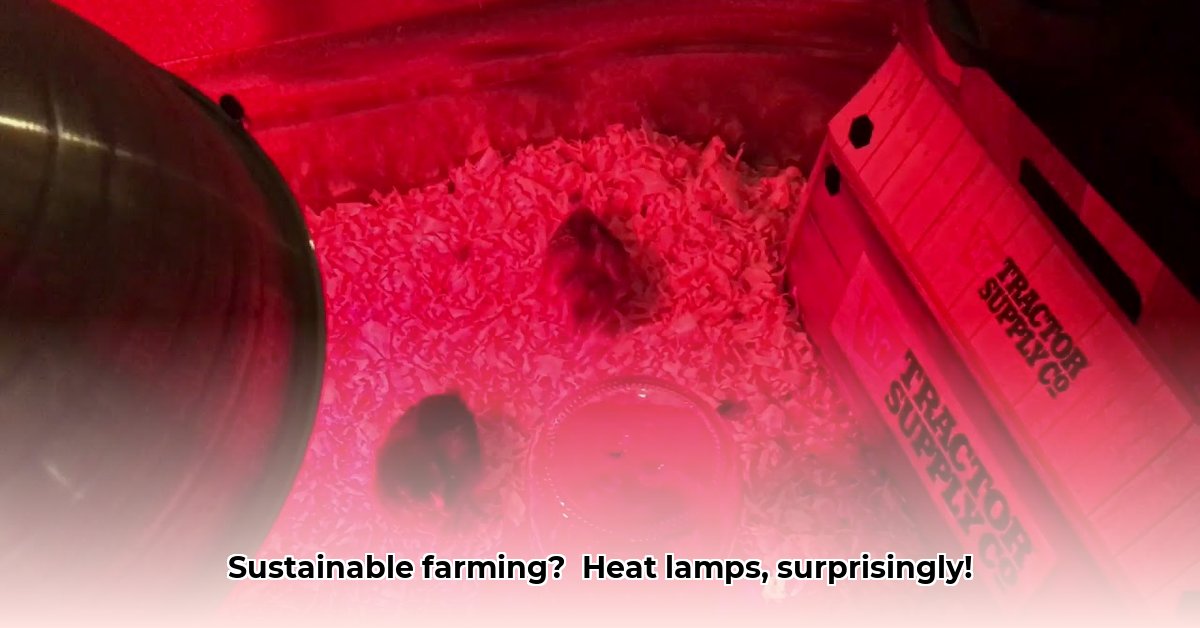
Finding the right heat lamp for your farm can be challenging. This guide helps you select, install, and use electric heat lamps effectively and sustainably, minimizing energy consumption and maximizing safety. We’ll cover choosing the right lamp, safe installation, energy-saving strategies, cost-benefit analysis, alternative heating methods, and regulatory compliance. For a wider selection, check out Tractor Supply's options.
Choosing the Right Heat Lamp: More Than Just Watts
Wattage isn't the only factor when selecting heat lamps. Consider heat output, energy efficiency, and longevity. Three main types exist:
Infrared Lamps: These provide gentle warmth, ideal for livestock and seedlings, but can be more expensive.
Halogen Lamps: Efficient and bright, they suit larger spaces but produce intense heat, posing a fire risk if improperly used.
Ceramic Heat Emitting Lamps: Durable and long-lasting, they're suitable for harsh conditions but are often pricier.
Comparison Table:
| Lamp Type | Pros | Cons | Best Suited For |
|---|---|---|---|
| Infrared | Gentle heat, low stress, good for animals | Higher initial cost | Livestock, young plants, nurseries |
| Halogen | Bright, efficient, good for large areas | Intense heat, fire risk if improperly used | Large spaces, plant propagation (with caution) |
| Ceramic | Long lifespan, durable, tough conditions | Relatively high cost, less versatile | Long-term use, harsh environments |
While Tractor Supply offers a selection, online retailers often provide broader comparisons and reviews. Always check multiple sources before purchasing.
Rhetorical Question: Aren't detailed energy efficiency comparisons crucial for making informed buying decisions?
Safe Installation and Use: Preventing Accidents
Heat lamps pose fire and burn risks. Prioritize safety with these steps:
Secure Mounting: Use a sturdy, rated fixture away from flammable materials. Improper mounting is a leading cause of heat lamp accidents.
Correct Wiring: Ensure wiring can handle the lamp's wattage, using appropriate gauge wire and secure connections. Faulty wiring is a major fire hazard.
Protective Shield: Employ a cage or guard to prevent animals from touching the hot bulb. Protecting your animals from burns is paramount.
Regular Inspection: Regularly check for damage to the wiring, fixture, and bulb, replacing damaged parts immediately. Proactive maintenance prevents accidents.
Emergency Preparedness: Keep a fire extinguisher nearby and have a fire safety plan in place. Being prepared is crucial in case of emergencies.
Energy Efficiency: Saving Money and the Environment
Reducing energy consumption is key to sustainable farming:
Improve Insulation: Better insulation reduces heat loss, lowering energy needs and costs. This simple step can dramatically impact energy savings.
Strategic Placement: Position lamps to maximize heat distribution and minimize wasted energy. Careful placement can significantly reduce energy consumption.
Timers and Thermostats: These automate lamp operation, providing heat only when needed and maintaining consistent temperatures. This automated control saves significant energy.
Explore Renewable Energy: Solar or wind power can reduce reliance on the electrical grid, lowering your carbon footprint and long-term energy bills. This is a long-term investment that significantly impacts sustainability.
Quantifiable Fact: Studies have shown that improved insulation can reduce heating costs by up to 30%.
Cost-Benefit Analysis: The Long Game
Consider the lamp's lifespan and running costs, not just the initial price. A higher upfront cost for a longer-lasting, more efficient lamp might ultimately save money. A thorough cost-benefit analysis will guide your decision.
Alternative Heating Methods: Sustainable Solutions
Explore alternatives for long-term sustainability:
Geothermal Heating: Uses the earth's stable temperature. While costly upfront, it offers true sustainability.
Solar Heating: Harnesses solar energy. Costs are decreasing, making it a viable option in sunny climates.
Regulatory Compliance: Staying on the Right Side of the Law
Adhere to animal welfare, fire safety, and energy regulations. Compliance protects your animals, your farm, and prevents legal issues.
Conclusion
By following this guide, you can effectively and sustainably use electric heat lamps for your farm. Remember, responsible farming balances immediate needs with long-term sustainability. Choosing the right lamp, prioritizing safety, and implementing energy-saving strategies will lead to long-term financial and environmental benefits.